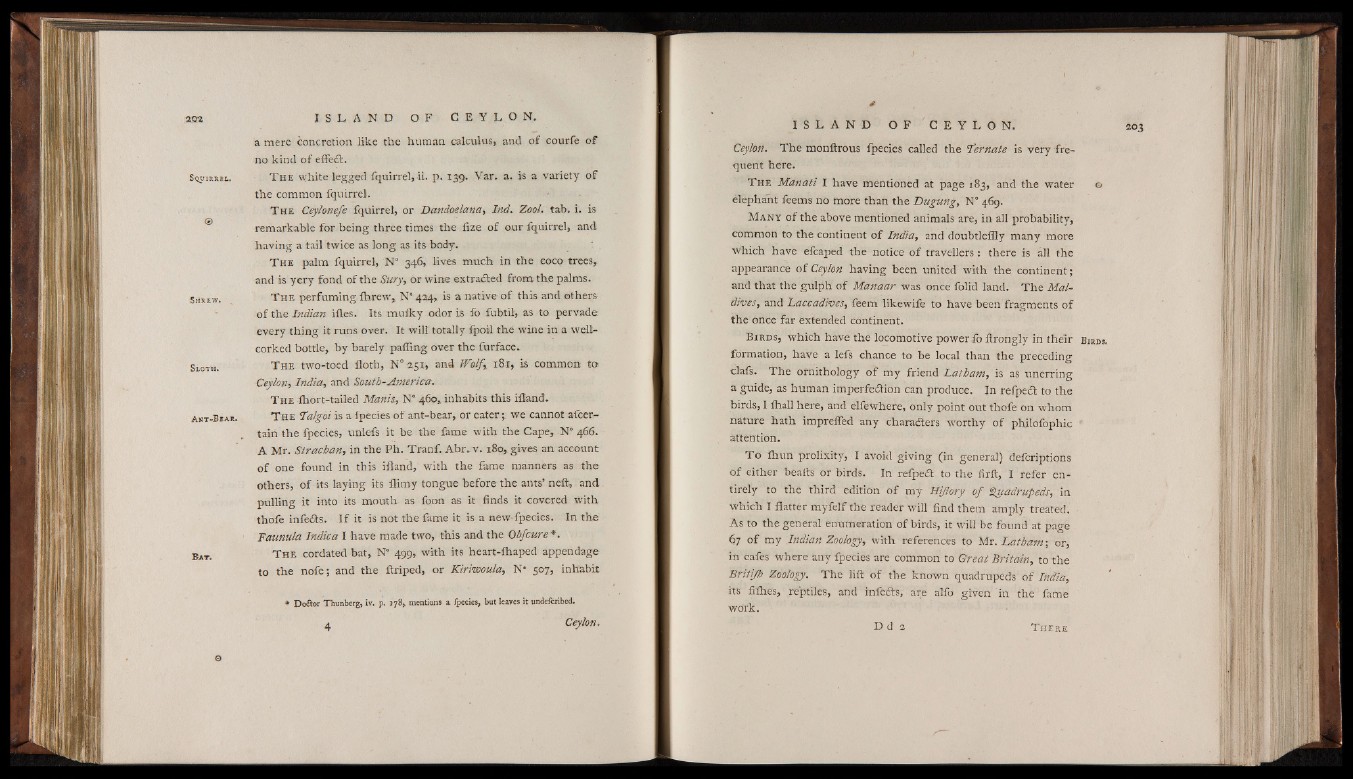
S q u i r r e l ,
©
S h r e w .
S l o t h .
A x t -B ear.
B a t .
a mere concretion like the human calculus, ancl of courfe of
no kind of effed.
T he white legged fquirrel, ii. p. 139. Var. a. is a variety o f
the common fquirrel.
T h e Ceylonefe fquirrel, or Landoelana, Ind.. Zool. tab. i. is
remarkable for being three times the iize of our fquirrel, and
having a tail twice as long as its body.
T he palm fquirrel, N° 346, lives much in the coco trees,
and is yery fond of the Sury, or wine extracted from the palms.
T he perfuming fhrew, N” 424,. is a native of this and others
of the Indian ifles. Its muiky odor is fo fubtil', as to pervade
every thing it runs over. It will totally fpoil thé wine in a well-
corked bottle, by barely palling over the furface.
T h e two-toed floth, N° 251, and Welfx 181, is common to,
Ceylon, India, and South-America.
T h e ihort-tailed Manis, N° 460, inhabits this ifland.
T h e I ’algoi is a fpeeies of ant-bear, or eater ; we cannot afcer-
tain the fpeeies, unlefs it be the fame with the Cape, N° 466,
A Mr. Strachan, in the Ph. Tranf. Abr. v. 180, gives an account
o f one found in this ifland, with the fame manners as the
others, of its laying its flimy tongue before the ants’ neft, and
pulling it into its mouth as foon as it finds it covered with
thofe infeds. If it is not the fame it is a new-fpeeies. In the
Faunula Indica I have made two, this and the Obfcure*.
T he cordatedbat, N" 499, with its heart-fhaped appendage
to the nofe; and the flriped, or Kiriwoula, N* 507, inhabit
* Doctor Thunberg, iv. p. 178, mentions a fpeeies, but leaves it undefcribed.
4 Ceylon,
o
4f
Ceylon. The monftrous fpeeies called the Ternate is very frequent
here.
T he Manatí I have mentioned at page 183, and the water ©
éléphant feems no more than the Dugung, N° 469.
Many o f the above mentioned animals are, in all probability,
common to the continent o f India, and doubtleffly many more
which have efcaped the notice o f travellers : there is all the
appearance o f Ceylon having been united with the continent ;
and that the gulph o f Manaar was once folid land. T he Maldives,
and Laccadives, feem likewife to have been fragments o f
the once far extended continent.
B i r d s , which have the locomotive power fo flrongly in their B i r d s .
formation, have a lefs chance to be local than the preceding
dais. The ornithology of my friend Latbant, is as unerring
a guide, as human imperfedion can produce. In refped to the
birds, I fhall here, and elfeWhere, only point out thofe on whom
nature hath impreffed any charaders worthy o f philofophic '
attention.
T o fhun prolixity, I avoid giving (in general) defcriptions
o f either beads or birds. In refped to the firft, I refer entirely
to the third edition o f my Hijlory o f Quadrupeds, in
Which I flatter myfelf the reader will find them amply treated.
As to the general enumeration of birds, it will be found at page
67 o f my Indian Zoology, with references to Mr. Latham ; or,
in cafes where any fpeeies are common to Great Britain, to the
Britijh Zoology. The lift of the known quadrupeds of India,
its fifties, reptiles, and mfeds, are alfo given in the fame
woTk.
D d 1 _■ T here